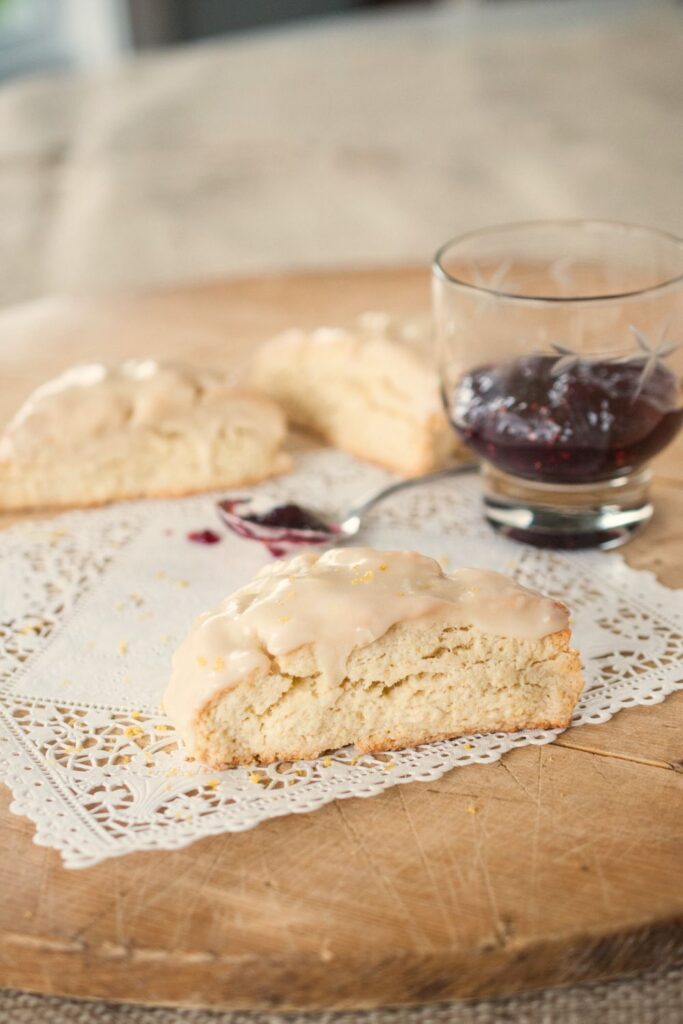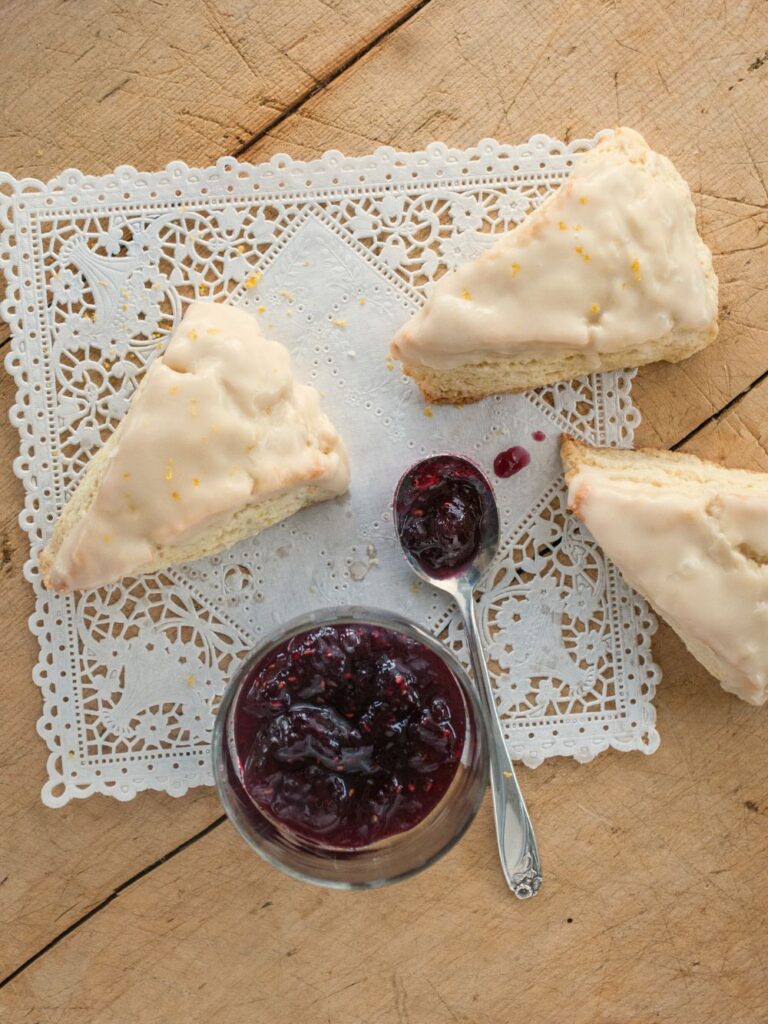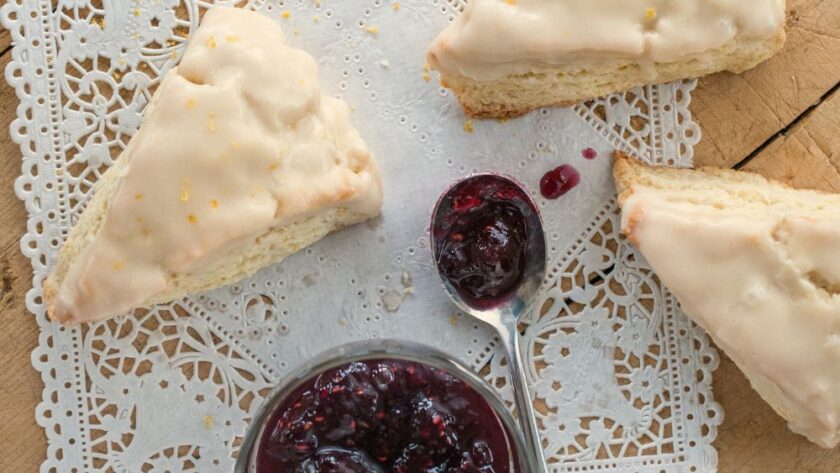There was always something cooling on a wire rack at hers — usually under a clean tea towel, “just to keep the draft off,” she’d say, even in summer. And more often than not, it was scones. The kind of scones you pull apart with your hands while they’re still warm, steam rising like a little puff of joy.
These Bero scones are a modern little riff on those classic bakes — soft, buttery, golden with a lovely whisper of vanilla… and just sweet enough to make your eyes close when you take the first bite. They’re not the dry, dusty triangles you sometimes get in shops. These are rich, crumbly-edged, and proper treat-yourself stuff.
I like them plain with a cup of builder’s tea, or jazzed up with a drizzle of vanilla glaze if I’m showing off. They’re fast, they’re forgiving, and they make your kitchen smell like something lovely just happened.
Why You’ll Love It
- Unfussy ingredients – Nothing weird or fancy here, just baking cupboard staples.
- Crispy golden edges + soft middles – Texture lovers, this one’s for you.
- Can be frozen before or after baking – Handy for emergencies. Or, let’s be honest, cravings.
- Customise away – Throw in choc chips, dried fruit, lemon zest… it all works.
- They make you look like you know what you’re doing – Always a bonus.
- One bowl, one tray, done – Minimal faff, maximum payoff.
Ingredients
For the scones:
- 2 cups (250g) all-purpose flour (spooned & leveled)
- 1/3 cup (65g) granulated sugar
- 1 tablespoon baking powder
- 1/2 teaspoon salt
- 6 tablespoons (85g) cold unsalted butter, cubed
- 1/2 cup (120ml) heavy whipping cream (plus more for brushing)
- 1 large egg
- 1 teaspoon pure vanilla extract
For the vanilla glaze:
- 1 cup (120g) powdered sugar
- 1–2 tablespoons (15–30ml) milk
- 1/2 teaspoon vanilla extract
How to Make It
Start with a cold bowl and colder butter:
Preheat your oven to 400°F (204°C). Line a baking tray with parchment or a silicone mat. In a big bowl, whisk the flour, sugar, baking powder, and salt together. Then chuck in your cold butter and cut it in using a pastry cutter or just your fingers. It should look like slightly clumpy breadcrumbs — don’t overdo it!
Stir it all together gently:
In a separate bowl or jug, whisk the cream, egg, and vanilla. Pour this into the dry mix and stir it just enough to bring the dough together. It’ll look a bit scrappy and shaggy — that’s what you want.
Shape it without overthinking:
Turn the dough out onto a lightly floured surface. Bring it together with your hands and gently pat it into a circle about 7 inches wide. No need to roll it. Slice into 8 wedges like a pizza.
Chill it briefly (if you can wait):
For taller, fluffier scones, stick the tray in the freezer for 5–10 minutes before baking. I skip this sometimes and they still turn out decent, but the chill does help.
Give them a glow-up:
Brush the tops with a little extra cream. You can sprinkle on coarse sugar if you’re skipping the glaze — I do that when I want more of a breakfasty vibe.
Bake until golden and proud:
Bake for 18–22 minutes until the tops are golden brown and your kitchen smells like a bakery. Let them cool for 10 minutes — just enough time to make your glaze.
Drizzle like you mean it:
Whisk together powdered sugar, milk, and vanilla until smooth. You’re going for a pourable but not runny glaze. Drizzle generously over the cooled scones, or dip the tops if you’re in the mood.

Common Mistakes and How to Dodge Them
Why are my scones dry?
Could be overmixing or your butter wasn’t cold enough. Keep it chill — literally.
Why didn’t they rise?
Check your baking powder isn’t ancient. Also, make sure you’re not squashing the dough flat before cutting.
Why’s my dough sticky?
Too much liquid or not enough flour. Add a tiny sprinkle of flour when shaping — but don’t panic, sticky dough often = moist scones.
Why do they taste bland?
Add a pinch more salt or a bit of lemon zest next time. And use real vanilla, not the fake stuff. Makes a world of difference.
Storage and Reheating
- Room temp: Keep in an airtight tin for up to 2 days.
- Fridge: Up to a week, but they’ll firm up a bit. Still lovely when reheated.
- Freezer: Freeze raw or baked. Wrap individually and keep for up to 3 months.
- To reheat:
- Oven: 350°F (175°C), 5–10 minutes.
- Microwave: 10–15 second bursts.
- Air fryer: 3–5 minutes at 350°F (175°C) — best for bringing back the crunch.
Frequently Asked Questions
Are scones bread or pastry?
Kind of both! They’re a quick bread technically, but with a buttery, flaky texture that edges into pastry territory.
Can I make them ahead?
Yes — make the dough, cut the wedges, freeze ’em on a tray, then bag them up. Bake straight from frozen (just add 2–3 mins to the time).
Do I need a pastry cutter?
Nope. Fingers, two knives, or a fork will do the trick. Just don’t melt the butter with your hands — quick and light is key.
Can I skip the glaze?
Absolutely. Brush with cream and sprinkle sugar before baking for a crisp, golden top instead.
Nutrition Facts (Per Serving):
- Calories: 398 kcal
- Total Fat: 16g
- Carbs: 56g
- Protein: 7g
- Sodium: 582mg
- Sugar: (depends on glaze, but approx. 14g)

Bero Scone Recipe
Description
Buttery, golden, and tender scones with a whisper of vanilla and an optional sweet glaze — perfect for teatime or lazy Sunday brunch.
Ingredients
For the glaze:
Instructions
- Preheat oven to 400°F (204°C). Line a baking tray.
- Mix dry ingredients, then cut in cold butter until crumbly.
- Whisk wet ingredients and stir into dry mix just until combined.
- Shape into a 7-inch round, cut into 8 wedges.
- Chill briefly, brush tops with cream.
- Bake 18–22 minutes until golden. Cool slightly.
- Drizzle with vanilla glaze and serve warm.
Notes
- Keep butter cold for flakiness.
- Don’t overmix or compress the dough.
- Freeze dough before baking for convenience.
- Adjust glaze texture to suit your drizzle dreams.

